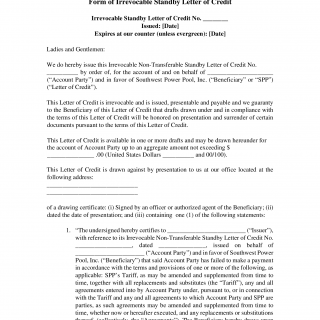Standby Letter of Credit
A Standby Letter of Credit (SLOC) is a financial instrument that serves as a guarantee of payment from a bank on behalf of their client. The main purpose of an SLOC is to provide assurance to a third party that their payment will be received in the event that the client is unable to make the payment themselves.
An SLOC typically consists of several parts, including a description of the agreement or transaction, the amount of the guarantee, the expiration date of the SLOC, and any conditions or requirements that must be met in order for the guarantee to be valid.
The parties involved in an SLOC are the bank providing the guarantee, the client requesting the guarantee, and the third party who is the beneficiary of the guarantee. It is important to consider the creditworthiness of the client and the likelihood of them being able to make the payment themselves before issuing an SLOC.
When filling out an SLOC form, important fields include the name and contact information of all parties involved, the amount of the guarantee, and any conditions or requirements that must be met. Additional documents that may need to be attached include a copy of the agreement or transaction that the SLOC is guaranteeing, as well as financial statements or other documentation that demonstrates the client's ability to make the payment themselves.
Application examples of an SLOC include when a company is bidding on a contract and needs to provide assurance to the client that they will be able to make the required payments, or when an individual is purchasing property and needs to provide assurance to the seller that they will be able to make the required payments.
Strengths of an SLOC include the ability to provide assurance to a third party that their payment will be received, even if the client is unable to make the payment themselves. Weaknesses may include the potential for the bank to incur losses if the client defaults on their payments.
Alternative forms to an SLOC may include a bank guarantee or a performance bond. The main difference between these forms is the type of obligation being guaranteed. An SLOC guarantees payment, while a bank guarantee guarantees the performance of a specific obligation, and a performance bond guarantees the performance of a contract.
To fill out and submit an SLOC form, it is recommended to work with a bank or financial institution that is experienced in issuing SLOCs. The completed form and any attached documentation should be stored securely, as they contain sensitive financial information.

